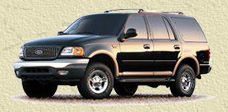

![]()


![]()

Ford introduced the Expedition in 1997. Larger than the Tahoe and Yukon, the Expedition can seat nine people with its optional third-row bench seat; the Tahoe and Yukon can only seat six.
One of the worst-kept secrets in the automotive industry is that Ford has been working on a "Suburban fighter" for a decade or more. Ford has the answer: the four-door Expedition. Positioned with GM in the crosshairs, the Expedition has be an impact player in the full-sized, four-door SUV market. But it comes at the expense of the Bronco-- Ford's full-sized two-door sport-ute is now dead.
Going back a couple of years, GM caught Ford was basking is the success of its Explorer SUV and quietly introduced two full-sized four-door sport-utilities: the Chevy Tahoe/GMC Yukon. Shorter than the Suburban, these four-door units surpassed everyone's expectations, and GM has had a tough time keeping up with the demand. Realizing this, Ford developed the Expedition to be about five inches longer than the Tahoe/Yukon but about 14 inches shorter than the Suburban.
The goals were to meet the full-sized four-door demand, lure away potential Suburban buyers with a vehicle that has a respectable towing capacity yet is easier to garage and park, and attract mini-van families that are tired of the geekish stigma.
At first glance, the Expedition is easily mistaken for a four-door Explorer whose grille has been backed into by a delivery truck. This familial resemblance is purely intentional--with literally millions of Explorers on the road, Ford knew that Americana responds to its styling. In fact, subtle differences between the two vehicles aren't apparent (and neither is the size difference) until the Explorer and Expedition are parked side-by-side. The similarities in names also blurs the distinction between these SUVs.
Although philosophically rooted in the Explorer, the Expedition borrows heavily from the '97 F-150. In fact, about 30% of their part numbers are the same, and the two vehicles are virtually identical from the A-pillar forward inside and out with the notable exception of their respective grilles. This overlap is one way that Ford is keeping costs down: fewer part numbers expedites manufacturing and means that dealerships and garages have to devote less space to parts stock. Also, Ford claims that the carryover F-150 componentry had 5,000,000 test miles on it before being included in the Expedition; unique Expedition parts have 2.5 million test miles on them. Common parts also allowed the Expedition to progress from drawing board to running prototype in only 34 months.
The old cliché about necessity being the mother of invention applies to the Expedition. In order to compete with GM's Big Three SUVs, Ford knew that the Expedition had to combine the best features of both the Suburban and four-door Tahoe/Yukon. One-upsmanship dictated a third-row seat to accommodate up to nine people to outdo the Tahoe/Yukon, which translated to a 119-inch wheelbase. Modern CAD/CAM allowed Ford to design a frame unique to the Expedition and computer-test it so that only a couple of actual steel models had to be built for real-world testing. The result is a rigid frame with its front two-thirds boxed - the computer demonstrated that boxing the rear C-channel would be a waste of money, which actual testing supported.
Part of the frame's dimensions were determined by cross-over F-150 components while others were dictated by common-sense factors. For example, Ford engineers knew that the Expedition had to have generous interior room and decent towing capacity to compete with GM, so they realized that four-wheel disc brakes were the best way to stop a big load. For better caliper clearance as well as improved aesthetics, Ford decided on optional cast-aluminum 17-inch rims and P265/70R17 tires for 4x4 models, so the Expedition's rear overhang was designed around the spare tire's dimensions. The desire for a 500 miles cruising range/30-gallon gas tank also factored into the equation.
Another design priority was rear-seat access. Here, Ford moved the B-pillar forward of the F-150's and narrowed the front door slightly to accommodate a wider rear door. Second-seat legroom is impressive, and that back-seat access and spaciousness is a huge selling point. Then the Expedition goes one step farther by offering an optional third seat for nine-person capacity - more people than can fit in the average bass boat. Access to it is less awkward than expected because the second-row passenger's seat folds forward and out of the way for almost van-like ingress. But the third seat's best feature is that it weighs only 72 pounds and removes without tools.
Rounding out the emphasis on comfort, the Expedition comes in two basic trim levels: XLT and Eddie Bauer. Options include separate climate controls for each row of seats, a leather interior and floor console (both standard on Eddie and optional on the XLT) as well as a standard Eddie Bauer overhead console with electronic display. Expeditions also have a power point on the dash with another in the console.
Last modified: Thursday December 13, 2007 07:35 AM